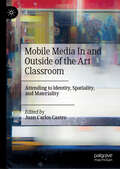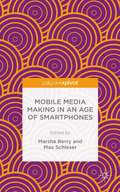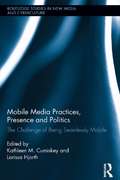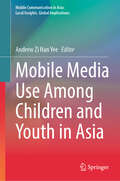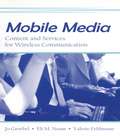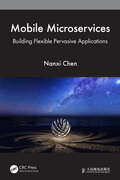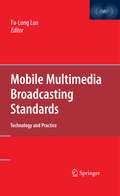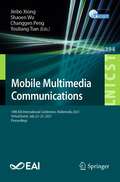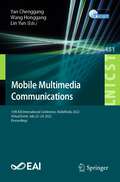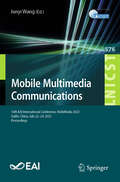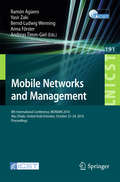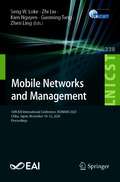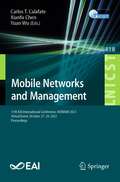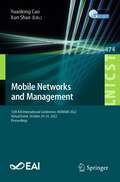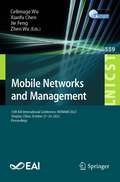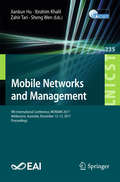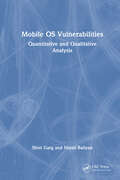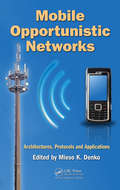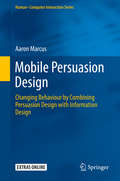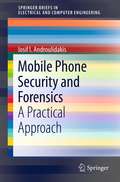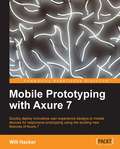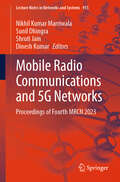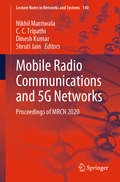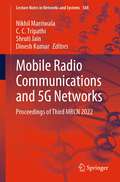- Table View
- List View
Mobile Media In and Outside of the Art Classroom: Attending to Identity, Spatiality, and Materiality
by Juan Carlos CastroThis edited volume explores a range of educational effects on student learning that resulted from a long-term study using a creative visual arts curriculum designed for mobile media (smartphones and tablets) and used in art classrooms. The curriculum, entitled MonCoin, a French phrase meaning My Corner, was initially designed and piloted in a Montreal area school for at-risk youth in 2012. Since then, it has been refined, deployed, and researched across secondary schools from a range of socio-cultural educational contexts. This book is comprised of contributions from researchers and practitioners associated with the MonCoin project who address critical insights gleaned from our study, such as the social context of teen mobile media use; curriculum theory and design; influences of identity on creative practice; and specific strategies for creative applications of mobile media in schools. The purpose of this edited book is to offer art education researchers and teachers innovative curriculum for mobile media and the networked conditions that influence identity, space, and practice with and through this ubiquitous technology.
Mobile Media Making in an Age of Smartphones
by Marsha Berry Max SchleserWith the rise of smartphones and the proliferation of applications ("apps"), the ways everyday media users and creative professionals represent, experience, and share the everyday is changing. With the overlay of location-based services, these experiences and representations are providing new social, creative, and emotional cartographies. This collection discusses the prospects of the proliferation of mobile and digital filmmaking opportunities, from videographic citizen journalism to networked, transmedia collaborative filmmaking and photography, and the embedding of filmmaking and photography in social media practice. The contributors reflect on emergent creative practices as well as digital ethnographies of new visualities and socialities associated with smartphone cameras in everyday life.
Mobile Media Practices, Presence and Politics: The Challenge of Being Seamlessly Mobile (Routledge Studies in New Media and Cyberculture)
by Larissa Hjorth Kathleen M. CumiskeyAs an example of convergence, the mobile phone—especially in the form of smartphone—is now ushering in new promises of seamlessness between engagement with technology and everyday common experiences. This seamlessness is not only about how one transitions between the worlds of the device and the physical environment but it also captures the transition and convergences between devices as well (i.e. laptop to smartphone, smartphone to tablet). This volume argues, however, that these transitions are far from seamless. We see divisions between online and offline, virtual and actual, here and there, taking on different cartographies, emergent forms of seams. It is these seams that this volume acknowledges, challenges and explores—socially, culturally, technologically and historically—as we move to a deeper understanding of the role and impact of mobile communication’s saturation throughout the world.
Mobile Media Use Among Children and Youth in Asia (Mobile Communication in Asia: Local Insights, Global Implications)
by Andrew Zi Han YeeThis book examines mobile media use among children and youths within an Asian context. By studying the impact of mobile media on children and youth in Asia, it focuses on the explosive growth of mobile media among young people and seeks to understand the potential consequences of mobile media use on society, relationships, and what it means to be a young person. With this, it provides a richly contextualized Asian voice to research on mobile media and young people, enriching the global conversation surrounding an increasingly central aspect of youths’ everyday lives. Research on mobile media and its impact on children and youths in Asia is not thoroughly represented, despite the proliferation of smartphone and tablet use in the region. This volume fills this gap by canvassing contemporary research on mobile media, children, and youth in Asia through the perspectives of emerging scholars in the region and beyond. It promotes an understanding of the motivations and patterns of use by children and youth in the region, examines contemporary research on the antecedents and consequences of mobile media use on society, relationships, and the individual, and provides a critique of mobile media use among children and youth. The volume also provides a culturally sensitive examination of mobile media use among children and youth, describing and analyzing policies enacted to manage young people’s smartphone use. It acknowledges Asia as a large and diverse region with differing linguistic, cultural, and sociopolitical traditions and contexts, and so the work does, as far as possible, look to ensure geographic and cultural diversity by prioritizing works from countries that are typically underrepresented. It is a relevant text to graduates and researchers in communication and media studies, social and developmental psychology, human development studies, science and technology, information systems, and design science.
Mobile Media: Content and Services for Wireless Communications (European Institute for the Media Series)
by Eli M. Noam Jo Groebel Valerie FeldmannThe proliferation of mobile media in recent years is an international phenomenon, with billions of devices sold annually. Mobile communications are now moving beyond individualized voice to mass media content--text, voice, sound, images, and even video. This will create new types of content that allow media companies and users to interact in new ways. There is a strong interest from the media and telecom industries in what manner of applications and content can be distributed in that fashion, and at what cost. To answer these questions, the book provides 18 chapters from internationally renowned authors. They identify likely types of content such as news, entertainment, peer-to-peer, and location-specific information; evaluate the economics, business models, and payment mechanisms necessary to support these media; and cover policy dimensions such as copyright, competitiveness, and access rights for content providers.This volume takes the reader through the various elements that need to be considered in the development of third generation (3G) content, and explains pitfalls and barriers. The result is a volume of interest to business professionals, academics, and policy makers.The book is international in focus and a glossary of terms is provided. There are few publications available which give an overview of this rapidly changing field.
Mobile Microservices: Building Flexible Pervasive Applications
by Nanxi ChenIn the 5G era, edge computing and new ecosystems of mobile microservices enable new business models, strategies, and competitive advantage. Focusing on microservices, this book introduces the essential concepts, technologies, and trade-offs in the edge computing architectural stack, providing for widespread adoption and dissemination. The book elucidates the concepts, architectures, well-defined building blocks, and prototypes for mobile microservice platforms and pervasive application development, as well as the implementation and configuration of service middleware and AI-based microservices. A goal-oriented service composition model is then proposed by the author, allowing for an economic assessment of connected, smart mobile services. Based on this model, costs can be minimized through statistical workload aggregation effects or backhaul data transport reduction, and customer experience and safety can be enhanced through reduced response times. This title will be a useful guide for students and IT professionals to get started with microservices and when studying the use of microservices in pervasive applications. It will also appeal to researchers and students studying software architecture and service-oriented computing, and especially those interested in edge computing, pervasive computing, the Internet of Things, and mobile microservices.
Mobile Multimedia Broadcasting Standards
by Fa-Long LuoThis volume provides a comprehensive and cohesive compilation of multi-standards and systems for mobile multimedia broadcasting. The material includes coverage of the basic principles, algorithms, and design trade off as well as examples of software and hardware that have been implemented at the system level. The first part of the book deals with system, implementation, compatibility and comparison of all the co-existing standards related to mobile TV and multimedia broadcasting including T-DMB, DAB, DVB-H/T, CMMB, Media-FLO, ISDB-T and WiMAX, ATSC digital TV and NTSC analog TV. The second part covers fundamental principles, algorithms, design and testing for baseband processing in mobile multimedia broadcasting. The third part consists of compression, transmission, error concealment, quality assessment and real-time implementation of video coding in broadcasting systems with emphasis on H.264 and AVS-M. The last four chapters are on the standards for audio coding, classification and surround effects. An overview of China's DRA audio coding standard and MPEG-4 AAC standard family (AAC, High Efficiency AAC and High Efficiency AAC Version 2) is given. The work also explains the general concepts behind spatial audio coding which are playing a very important role in digital audio/multimedia broadcasting systems for multi-channel contents. Mobile Multimedia Broadcasting Standards: Technology and Practice is an invaluable reference for engineers, researchers, broadcasters, manufacturers, network operators, software developers, content providers and others involved in the delivery of multimedia enriched contents to mobile systems.
Mobile Multimedia Communications: 14th EAI International Conference, Mobimedia 2021, Virtual Event, July 23-25, 2021, Proceedings (Lecture Notes of the Institute for Computer Sciences, Social Informatics and Telecommunications Engineering #394)
by Jinbo Xiong Shaoen Wu Changgen Peng Youliang TianThis book constitutes the thoroughly refereed post-conference proceedings of the 14th International Conference on Mobile Multimedia Communications, Mobimedia 2021, held in July 2021. Due to COVID-19 pandemic the conference was held virtually. The 66 revised full papers presented were carefully selected from 166 submissions. The papers are organized in topical sections as follows: Internet of Things and Wireless Communications Communication; Strategy Optimization and Task Scheduling Oral Presentations; Privacy Computing Technology; Cyberspace Security and Access control; Neural Networks and Feature Learning Task Classification and Prediction; Object Recognition and Detection.
Mobile Multimedia Communications: 15th EAI International Conference, MobiMedia 2022, Virtual Event, July 22-24, 2022, Proceedings (Lecture Notes of the Institute for Computer Sciences, Social Informatics and Telecommunications Engineering #451)
by Lin Yun Yan Chenggang Wang HonggangThis book constitutes the thoroughly refereed post-conference proceedings of the 15th EAI International Conference on Mobile Multimedia Communications, MobiMedia 2022, held in July 22-24, 2022. Due to COVID-19 pandemic the conference was held virtually. The 29 full papers presented were carefully selected from numerous submissions. The papers are organized in topical sections as follows: Internet of Things and Wireless Communications Communication Strategy Optimization; Cyberspace Security on Cryptography, Privacy Protection, Data Sharing, Access Control and Task Prediction; Neural Networks and Feature Learning; and Object Recognition and Detection.
Mobile Multimedia Communications: 16th EAI International Conference, MobiMedia 2023, Guilin, China, July 22-24, 2023, Proceedings (Lecture Notes of the Institute for Computer Sciences, Social Informatics and Telecommunications Engineering #576)
by Junyi WangThis proceedings constitutes the referred post-conference proceedings of the 16th International Conference on Mobile Multimedia Communications, MOBIMEDIA 2023, held in Guilin, China, during July 22 - 24, 2023. The 35 full papers and 17 short papers presented were carefully selected from 77 submissions. The papers were organized as follows: cutting-edge technologies in wireless communication, in information as well as topics of signal processing and new generation wireless communication.
Mobile Networks and Management
by Anna Förster Ramón Agüero Bernd-Ludwig Wenning Andreas Timm-Giel Yasir ZakiThis book constitutes the post-proceedings of the 5th International ICST Conference on Mobile Networks and Management, MONAMI 2013, held in Cork, Ireland, in September 2013. The 18 revised full papers presented were carefully reviewed and selected from numerous submissions. The volume is organized thematically in five parts, covering: TCP, multi-path and coding and content-centric networking; mobile networks; wireless sensor and vehicular networks; wireless communications and traffic; future research directions, including cloud connectivity, orchestration and SDN.
Mobile Networks and Management: 10th EAI International Conference, MONAMI 2020, Chiba, Japan, November 10–12, 2020, Proceedings (Lecture Notes of the Institute for Computer Sciences, Social Informatics and Telecommunications Engineering #338)
by Kien Nguyen Seng W. Loke Zhi Liu Guoming Tang Zhen LingThis book constitutes the refereed post-conference proceedings of the 10th International Conference on Mobile Networks and Management, MONAMI 2020, held in Chiba, Japan, in November 2020. The conference was held virtually due to the COVID-19 pandemic.The 19 full papers were carefully reviewed and selected from 41 submissions. The papers are divided into groups of content as follows: Application of artificial intelligence for smart city; Advanced technology in edge computing; Recent advances in mobile communications and computing; Emerging technologies and applications in mobile networks and management.
Mobile Networks and Management: 11th EAI International Conference, MONAMI 2021, Virtual Event, October 27-29, 2021, Proceedings (Lecture Notes of the Institute for Computer Sciences, Social Informatics and Telecommunications Engineering #418)
by Yuan Wu Carlos T. Calafate Xianfu ChenThis book constitutes the refereed post-conference proceedings of the 11th International Conference on Mobile Networks and Management, MONAMI 2021, held in October 2021. The conference was held virtually due to the COVID-19 pandemic. The 26 full papers were carefully reviewed and selected from 53 submissions. The papers are divided into groups of content as follows: The application of artificial intelligence for smart city; Advanced technology in edge and fog computing; Emerging technologies and applications in mobile networks and management; and Recent advances in communications and computing.
Mobile Networks and Management: 12th EAI International Conference, MONAMI 2022, Virtual Event, October 29-31, 2022, Proceedings (Lecture Notes of the Institute for Computer Sciences, Social Informatics and Telecommunications Engineering #474)
by Yuanlong Cao Xun ShaoThis book constitutes the refereed post-conference proceedings of the 12th EAI International Conference on Mobile Networks and Management, MONAMI 2022, which took place virtually during October 29-31, 2022.The 31 full papers were carefully reviewed and selected from 78 submissions. The papers are divided into groups of content as follows: Innovative Artificial Intelligence Applications for Smart City; The New Era of Computer Network by using Machine Learning; Advanced Technologies in Edge and Fog Computing; Emerging Technologies in Mobile Networks and Management; and Recent Advances in Communications and Computing.
Mobile Networks and Management: 13th EAI International Conference, MONAMI 2023, Yingtan, China, October 27-29, 2023, Proceedings (Lecture Notes of the Institute for Computer Sciences, Social Informatics and Telecommunications Engineering #559)
by Jie Feng Zhen Wu Xianfu Chen Celimuge WuThis book constitutes the refereed post-conference proceedings of the 13th International Conference on Mobile Networks and Management, MONAMI 2023, held in Yingtan, China, in October 2023. The 21 full papers were carefully reviewed and selected from 41 submissions. The papers are divided into groups of content as follows: Wireless Communication and Networks; Network Security and Blockchain; Image Processing and Computer Vision; Distributed Computing; Emerging Applications.
Mobile Networks and Management: 9th International Conference, Monami 2017, Melbourne, Australia, December 13-15, 2017, Proceedings (Lecture Notes of the Institute for Computer Sciences, Social Informatics and Telecommunications Engineering #235)
by Sheng Wen Jiankun Hu Ibrahim Khalil Zahir TariThis book constitutes the refereed post-conference proceedings of the 9th International Conference on Mobile Networks and Management, MONAMI 2017, held in Melbourne, Australia, in December 2017. The 30 revised full papers were carefully reviewed and selected from 43 submissions. The papers handle topics in the area of mobile computing, wireless networking and management.
Mobile OS Vulnerabilities: Quantitative and Qualitative Analysis
by Niyati Baliyan Shivi GargThis is book offers in-depth analysis of security vulnerabilities in different mobile operating systems. It provides methodology and solutions for handling Android malware and vulnerabilities and transfers the latest knowledge in machine learning and deep learning models towards this end. Further, it presents a comprehensive analysis of software vulnerabilities based on different technical parameters such as causes, severity, techniques, and software systems’ type. Moreover, the book also presents the current state of the art in the domain of software threats and vulnerabilities. This would help analyze various threats that a system could face, and subsequently, it could guide the securityengineer to take proactive and cost-effective countermeasures. Security threats are escalating exponentially, thus posing a serious challenge to mobile platforms. Android and iOS are prominent due to their enhanced capabilities and popularity among users. Therefore, it is important to compare these two mobile platforms based on security aspects. Android proved to be more vulnerable compared to iOS. The malicious apps can cause severe repercussions such as privacy leaks, app crashes, financial losses (caused by malware triggered premium rate SMSs), arbitrary code installation, etc. Hence, Android security is a major concern amongst researchers as seen in the last few years. This book provides an exhaustive review of all the existing approaches in a structured format. The book also focuses on the detection of malicious applications that compromise users' security and privacy, the detection performance of the different program analysis approach, and the influence of different input generators during static and dynamic analysis on detection performance. This book presents a novel method using an ensemble classifier scheme for detecting malicious applications, which is less susceptible to the evolution of the Android ecosystem and malware compared to previous methods. The book also introduces an ensemble multi-class classifier scheme to classify malware into known families. Furthermore, we propose a novel framework of mapping malware to vulnerabilities exploited using Android malware’s behavior reports leveraging pre-trained language models and deep learning techniques. The mapped vulnerabilities can then be assessed on confidentiality, integrity, and availability on different Android components and sub-systems, and different layers.
Mobile Opportunistic Networks: Architectures, Protocols and Applications
by Mieso K. DenkoFrom fundamentals to advanced concepts, this book provides comprehensive technical coverage of this rapidly emerging communications technology. The first section focuses on modeling, networking architecture, and routing problems. The second section examines opportunistic networking technologies and applications. Supplying detailed discussions of key research challenges and open issues, this comprehensive resource provides a clear understanding of industrial and professional standards, communication architectures, network algorithms and protocols, emerging applications, and the latest experimental studies-including simulation tools and implementation test beds.
Mobile Persuasion Design
by Aaron MarcusMobile Persuasion Design presents ten conceptual design projects (or 'Machines') for new mobile application's (smartphone or tablet with Web portals) that combine theories of persuasion and information design to change people's behaviour. Areas such as the environment, health, learning and happiness are explored, looking at ways of marrying people's wants and needs to make simple, usable and desirable mobile applications. A user-centred design approach has been used, adopting user experience (UX) methods, in-depth case studies and market analysis to see what a modern user needs from their mobile application. By applying concepts like persuasion theory and information architecture, try to find ways to satisfy these needs and positively change their user habits. In 2011, the Green, Health, and Money Machines won design awards in an international competition hosted by the International Institute for Information Design, Vienna.
Mobile Persuasion: 20 Perspectives on the Future of Behavior Change
by B. J. FoggThe mobile phone will soon become the most powerful channel for persuasion. This book presents 20 perspectives on how mobile devices can be designed to motivate and influence people - and how this emerging trend will change the way you live, work, and play.
Mobile Phone Security and Forensics
by I. I. AndroulidakisMobile Phone Security and Forensics provides both theoretical and practical background of security and forensics for mobile phones. The author discusses confidentiality, integrity, and availability threats in mobile telephones to provide background for the rest of the book. Security and secrets of mobile phones are discussed including software and hardware interception, fraud and other malicious techniques used "against" users. The purpose of this book is to raise user awareness in regards to security and privacy threats present in the use of mobile phones while readers will also learn where forensics data reside in the mobile phone and the network and how to conduct a relevant analysis.
Mobile Prototyping with Axure 7
by Will HackerThis book is a step-by-step tutorial which includes hands-on examples and downloadable Axure files to get you started with mobile prototyping immediately. You will learn how to develop an application from scratch, and will be guided through each and every step.If you are a mobile-centric developer/designer, or someone who would like to take their Axure prototyping skills to the next level and start designing and testing mobile prototypes, this book is ideal for you. You should be familiar with prototyping and Axure specifically, before you read this book.
Mobile Radio Communications and 5G Networks: Proceedings of Fourth MRCN 2023 (Lecture Notes in Networks and Systems #915)
by Dinesh Kumar Shruti Jain Nikhil Kumar Marriwala Sunil DhingraThis book features selected high-quality papers from the Forth International Conference on Mobile Radio Communications and 5G Networks (MRCN 2023), held at University Institute of Engineering and Technology, Kurukshetra University, Kurukshetra, India, during August 25–26, 2023. The book features original papers by active researchers presented at the International Conference on Mobile Radio Communications and 5G Networks. It includes recent advances and upcoming technologies in the field of cellular systems, 2G/2.5G/3G/4G/5G, and beyond, LTE, WiMAX, WMAN, and other emerging broadband wireless networks, WLAN, WPAN, and various home/personal networking technologies, pervasive and wearable computing and networking, small cells and femtocell networks, wireless mesh networks, vehicular wireless networks, cognitive radio networks and their applications, wireless multimedia networks, green wireless networks, standardization of emerging wireless technologies, power management and energy conservation techniques.
Mobile Radio Communications and 5G Networks: Proceedings of MRCN 2020 (Lecture Notes in Networks and Systems #140)
by Dinesh Kumar Shruti Jain Nikhil Marriwala C. C. TripathiThe book features original papers by active researchers presented at the International Conference on Mobile Radio Communications and 5G Networks. It includes recent advances and upcoming technologies in the field of cellular systems, 2G/2.5G/3G/4G/5G and beyond, LTE, WiMAX, WMAN, and other emerging broadband wireless networks, WLAN, WPAN, and various home/personal networking technologies, pervasive and wearable computing and networking, small cells and femtocell networks, wireless mesh networks, vehicular wireless networks, cognitive radio networks and their applications, wireless multimedia networks, green wireless networks, standardization of emerging wireless technologies, power management and energy conservation techniques.
Mobile Radio Communications and 5G Networks: Proceedings of Third MRCN 2022 (Lecture Notes in Networks and Systems #588)
by Dinesh Kumar Shruti Jain Nikhil Marriwala C. C. TripathiThis book features selected high-quality papers from the Third International Conference on Mobile Radio Communications and 5G Networks (MRCN 2022), held at University Institute of Engineering and Technology, Kurukshetra University, Kurukshetra, India, during June 10–12, 2022. The book features original papers by active researchers presented at the International Conference on Mobile Radio Communications and 5G Networks. It includes recent advances and upcoming technologies in the field of cellular systems, 2G/2.5G/3G/4G/5G, and beyond, LTE, WiMAX, WMAN, and other emerging broadband wireless networks, WLAN, WPAN, and various home/personal networking technologies, pervasive and wearable computing and networking, small cells and femtocell networks, wireless mesh networks, vehicular wireless networks, cognitive radio networks and their applications, wireless multimedia networks, green wireless networks, standardization of emerging wireless technologies, power management and energy conservation techniques.
